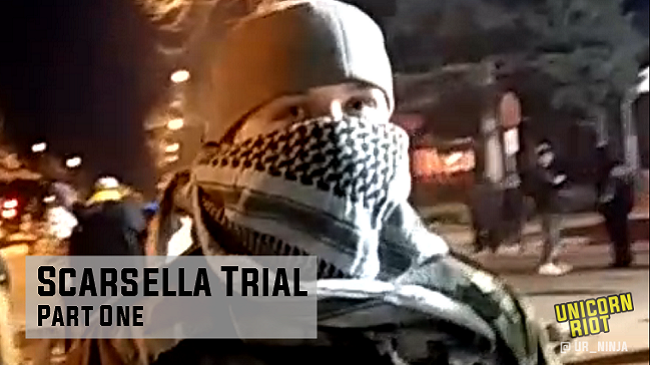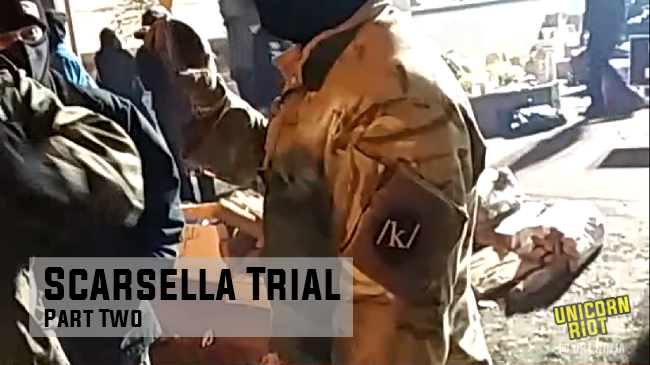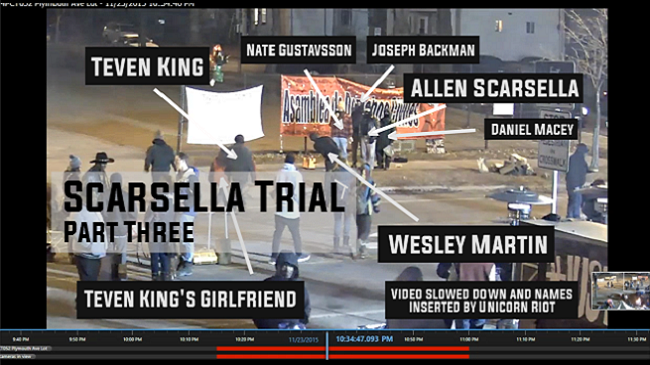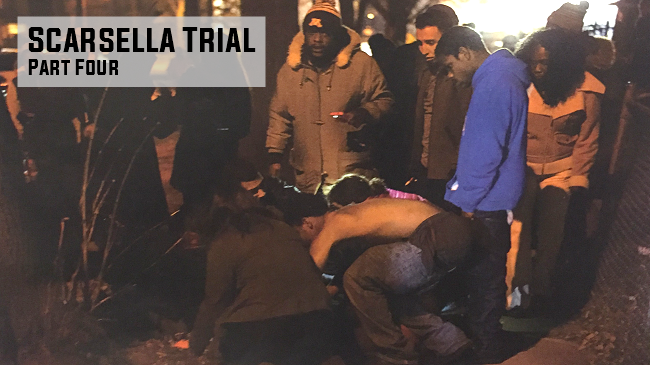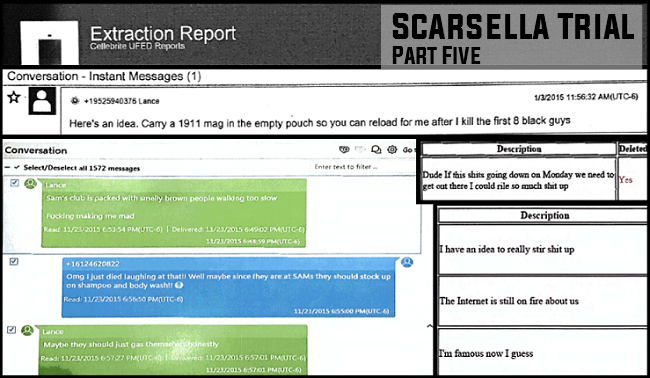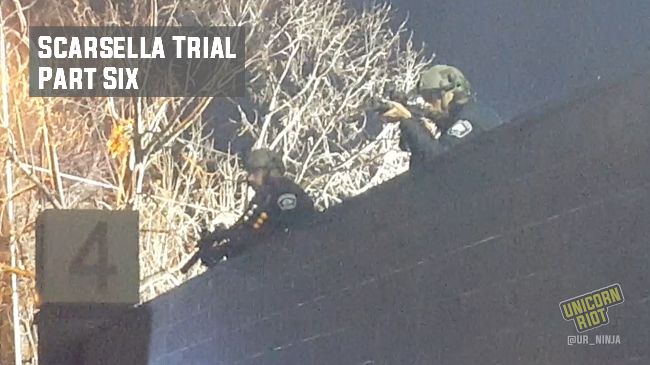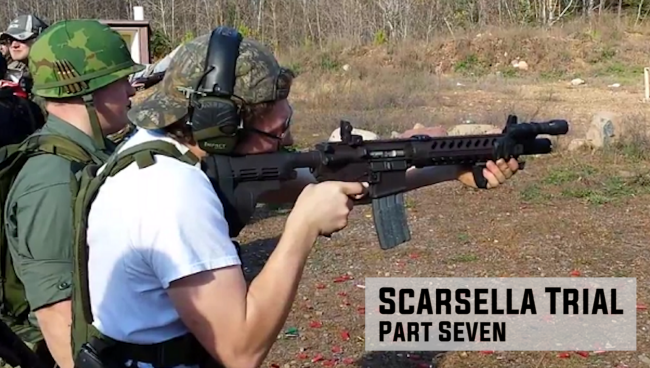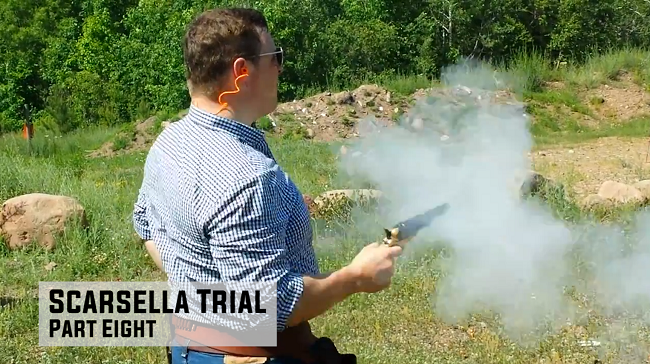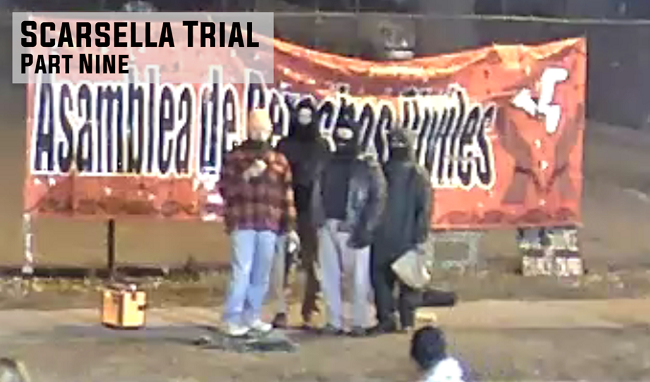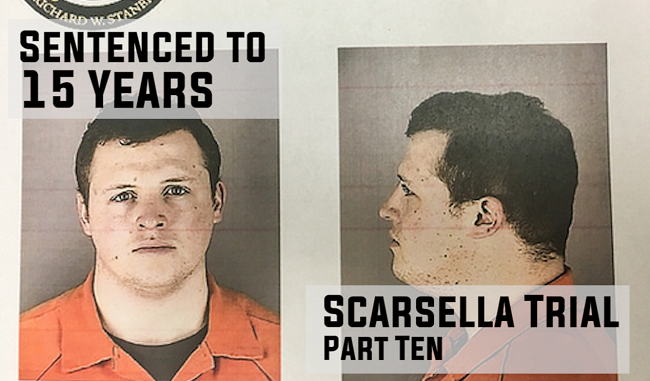Scarsella Trial – Part Three: Jury Sees Videos Around Mass Shooting
Minneapolis, MN – In November of 2015, gun enthusiast and racist 4channer Allen ‘Lance’ Scarsella physically trolled Jamar Clark protests with a firearm two times in four days. During his second visit he brought three friends with him, they got into an altercation and Allen shot five unarmed protesters. Allen was arrested by police the next day–he has been in protective custody in jail ever since–and pled self-defense during his trial.
This is the third part of Unicorn Riot’s comprehensive report-backs from the Scarsella Trial, covering testimony and exhibits, including video from January 19th, 2017.
Read Scarsella Trial – Part One: Jury Selection, Unicorn Riot Subpoenaed, Opening Statements by clicking on the image below:
Read Scarsella Trial – Part Two: “In hindsight it was very stupid” by clicking on the image below:
As we found out in Scarsella Trial – Part Two, Allen Scarsella and his group of co-defendants, Daniel Macey (PDF) (27 y/o – Pine Ridge, MN), Joseph Backman (PDF) (28 y/o – Eagan, MN), and Nathan Gustavsson (PDF) (22 y/o – Hermantown, MN), are all part of the growing movement of white nationalists clustered around bigoted ideology in chat forums on the internet. The case hinged on documenting their intolerant subculture as a motive for the armed attack, namely speaking and posting about white-supremacist ideals through memes and terminology not recognized by the larger majority of the populace.
Allen Scarsella (PDF) who turned 25 years old on February 25th, was found guilty on all twelve felonies levied against him on February 1st, 2017. His charges include, one count of first-degree assault, one count of second-degree riot while armed, and five counts of second-degree assault with a dangerous weapon – causing substantial bodily harm, as well as, five more counts of second-degree assault with a dangerous weapon (note: on January 31st, Hennepin County Attorney’s Office added the five counts of second-degree assault with a dangerous weapon).
[Content Advisory: some of the language seen in this article may be disturbing and offensive to our audience.]
Watch the video below for a timeline of events that led to the shooting:
We begin Part Three in Judge Hilary Lindell Caligiuri‘s courtroom on the 16th floor of the Hennepin County Government Center, after the morning break on Thursday, January 19th, 2017.
Police officers and a doctor dominated the second and third days since the swearing-in of the jury and opening statements. Here is our detailed report of the witness testimony.
WITNESS TESTIMONY – DAY THREE (JANUARY 19TH) – PART 2 (Part 1 started in Scarsella Trial Part 2)
(Names of people on the stand testifying are signified by italics)
The doctor who worked on shooting victim Teven King took the stand after being told by the prosecuting attorneys in the hallway to not include the statement that Teven would have likely died had he arrived at the hospital a half hour later. This hypothesis was said in the opening statements by the prosecuting attorney Judith Hawley and objected by the defense and spoken about by the judge before opening the witnesses testimonies up.
Teven suffered the most serious injury, that of a gunshot to the abdomen. Teven’s doctor said that when Teven was in the hospital he had lost “three liters of blood from the injuries sustained,” two of which were lost “getting control of the injury.” His doctor spoke about how they had to remove parts of Teven’s intestines and sew them back together and how Teven will have the bullet stuck in his pelvis for the remainder of his life, as it could kill him if removed.
Jenny Bunkers, a night supervisor for the City of Minneapolis Crime Lab unit, was called as a witness after morning break on January 19th. Bunkers said she’s been in the Crime Lab for over a decade and had worked “over 1,000 crime scenes” and “over 500 shootings.”
Bunkers spoke about getting the call, putting her bullet-proof vest on and arriving at the scene of the crime where five victims were shot and the assailants were “believed to have fled the scene.”
She said they discovered discharged cartridge casings, blood, clothing, jackets, scarves, and gloves on the scene. She collected and inventoried the items and the other three crime lab specialists took photos and surveyed the area.
Bunkers talked a bit about the scene that she witnessed when arriving to 14th Ave. and Morgan Ave. She said there was a large amount of police personnel and some civilians on the perimeter, and stated that two victims were transported by EMS to the hospital and three left the scene to get to the hospital in a car.
Dozens of pictures were then presented to the court as evidence. Many of the photos presented during Bunker’s testimony were photos that she took when she arrived at the scene, including aerial photos of the area. They were shown on a large screen that was at the back of the courtroom in between the witness stand and the jury box.
Assistant Hennepin County Attorney Judith Hawley had Bunkers describe the location of the evidence that the police retrieved on the night of November 23th, 2015. Bunkers pointed to markers in the photo that were about twenty to thirty feet north of the beginning of the east side of the 1400 block of Morgan Avenue. She said that those yellow markers were where they found eight discharged cartridge casings. Blood and a cigarette (which Draper Larkins was smoking) was found about ten feet south and close to the sidewalk on the east side of Morgan Ave. near 14th Ave.
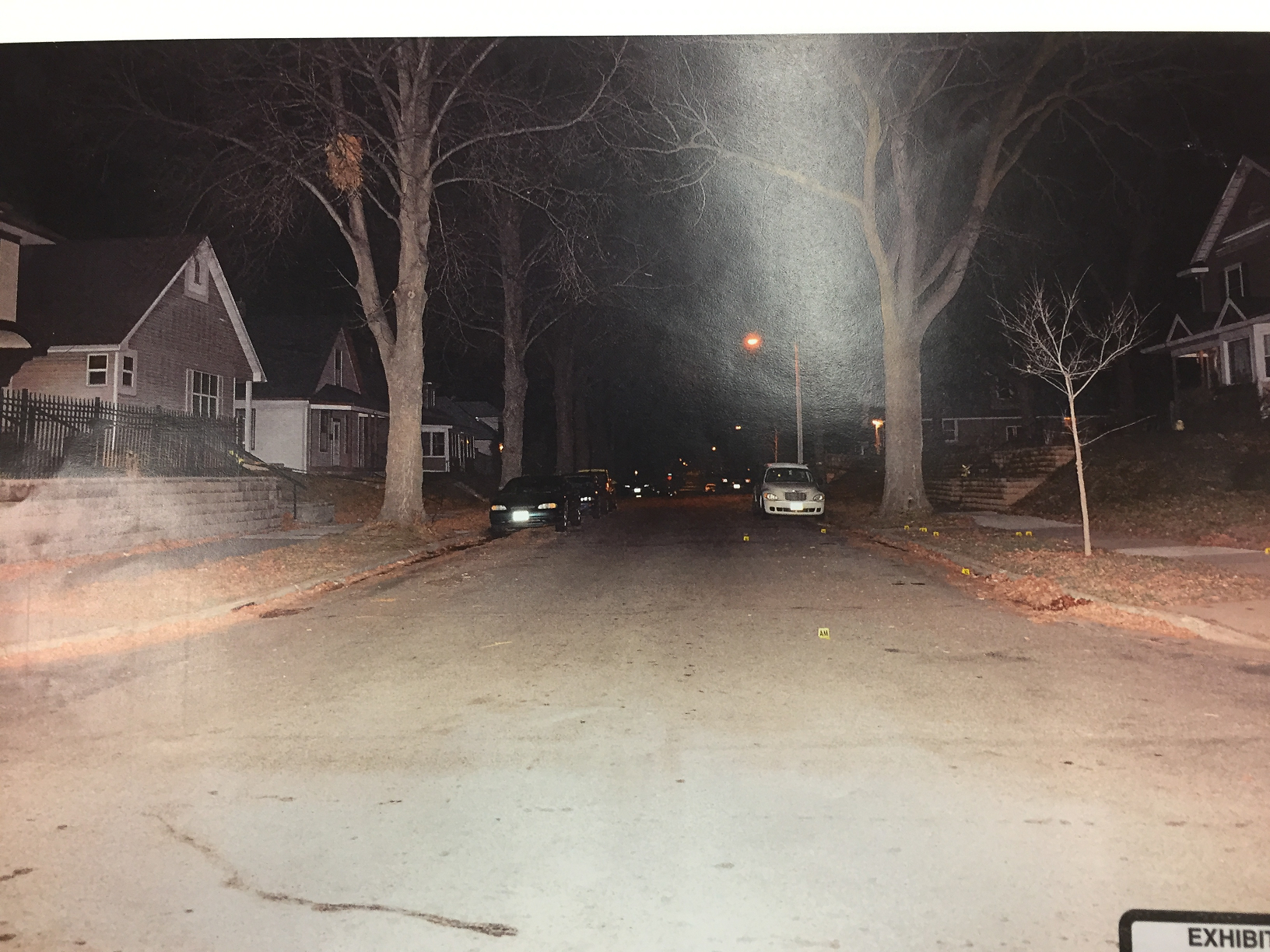
She spoke of finding a bullet hole in the back of a red Mercury Cougar, which was shown in Exhibits 10 and 11. The Cougar was parked near the end of the 1300 block of Morgan on the east side of the block.
A half block south of the bullet casings was a glove, some blood, and three jackets. Bunkers said they inventoried a cell phone and some loose change from the three jackets found in front of 1331 Morgan Avenue North and that those jackets were some of the victims’ clothing.
After a lunch break, Sergeant John Sheneman took the stand. He works as a SWAT officer for the Minneapolis Police Department. He testified about getting the “ShotSpotter call” and showing up to the crime scene. ShotSpotter 360° microphones placed throughout Minneapolis automatically record times around gunshots; the manufacturer claims other recordings are not generated.
Sheneman was also involved in the SWAT raid on Scarsella’s house the day after the shooting and brought forth many pictures from inside of Scarsella’s residence.
Another police officer, Bowen Barnard of the 5th Precinct, was next. He was on special assignment to the 4th Precinct when he was the first to respond to the shooting on Morgan and 14th. Barnard ended up giving medical help to shooting victims Wesley Martin and Teven King (the latter whom he rode to the hospital with).
Officer Barnard was driving when he received the notice from the city’s “shot spotter detection system” that shots had been fired at the 1400 block of Morgan Avenue. He stated that when he arrived, he parked his squad car in the middle of Morgan Avenue halfway down the 1300 block from the 1400 block. Barnard said that it was
“mass chaos when we got out of our car, people screaming that they needed help.” – MPD Officer Barnard
He called the scene “mass chaos” multiple times in his testimony and said that people were “yelling at us to do something, the best we could do was to tell them to backup” so that the police could survey the scene and find the victims.
He stated that there was a “large group of protestors heading from the 4th Precinct, northbound on Morgan Avenue” and a lot of officers continued onto the scene. He said that many police “showed up to make a line to keep the protesters” away from the crime scene.
Amidst the “chaos“, officer Barnard medically assisted King and Martin and spoke about how EMS strayed from their normal protocol and came on site to tend to the wounded because of the direness of the situation. He, along, with firefighters and EMS, helped treat Teven, later saying about Teven,
“He wasn’t very responsive to the questions I asked.” – Officer Barnard says of Teven King after Teven is shot in the stomach
Following the afternoon break, Teven’s and Wesley’s clothing were admitted into evidence and displayed for the jury. During cross examination, the defense was keying in on where Barnard had to park his car when he initially arrived at the scene.
Barnard stated that as he pulled up to the scene and parked near 1329 Morgan Ave., a large boisterous crowd was outside in the street and it prohibited him from driving any further. “They were yelling to help,” he said, and explained that he was concerned for his and his partner’s safety and that he wouldn’t go into the crowd by himself.
Defense attorney Peter Martin then made insinuations that victims Teven and Wesley both had criminal records and that Officer Barnard had previously knew their names “because they were already in your [MPD] computer,” to which a sustained objection pushed Martin to revert back to what he perceived as the unruly crowd that hindered Barnard’s car from driving down Morgan without issue.
Jeffrey York was called as the next witness, he works the 4th Precinct “dog watch,” has been a sergeant for the last twenty-one years, and rides squad car 403. Sgt. York was working overtime/buy-back to assist 4th Precinct operations on the 23rd of November, 2015. He was partnered with Sgt. Nicholas Rowe that night and was at 32nd and Dupont Ave. North when they received the call of shots fired.
He stated they went “code three” to the scene (lights and sirens activated) and arrived within 2 minutes. York spoke about when he arrived at the scene and said he saw “dozens and dozens of people swirling around, it was basically an unruly mob.”
He stated that Sgt. Fry was the incident commander and that he helped stabilize the shooting scene and move people back. He also spoke about the many “citizens” that helped calm down the situation.
York said that a few minutes after arriving, citizens helped secure the crime scene, and he sent officers to canvas both sides of Morgan Avenue. York then walked back to his squad car to move it to create room for the emergency vehicles and noticed that he was parked near shell casings and a “spattering of blood.” He said he then backed his car up further north on Morgan Avenue.
During the cross-examination of Sgt. York, the defense keyed in on what the situation was like for the officers when they arrived at the scene and the role of the citizens that were present.
York said that at the shooting scene, he was dealing with “unruly people making accusations that the police did this” and that “citizens were fighting amongst themselves” to decide if they would talk to the police. He stated that there was some pushing and shoving but he saw no punches thrown between citizens.
The defense brought up York’s written incident report that stated that the yellow crime scene tape was put up after he moved his car away from the bullet casings. Defense attorney Heinrich quickly seemed to focus on the possibility that York disrupted evidence when he originally arrived to the scene. After a couple short questions during cross, York was excused from the stand.
A set of very important videos were entered into evidence during the latter part of Thursday the 20th, as Sergeant Kelly O’Rourke was called by the prosecution.
O’Rourke is an investigator in the Violent Crimes Division and was the lead investigator of the team that took part in investigating the Scarsella shooting. The rest of his team consisted of Sergeants Metcalfe, Olson, Moryc, Benner, and Freeman.
Shortly after O’Rourke took the stand, Hennepin County prosecuting attorney Chris Freeman asked O’Rourke to differentiate the job of a patrol officer to that of an investigator, to which he replied mainly that patrol officers are first responders and it’s his job as an investigator to put together the secondary evidence.
Exhibit 110, a video from a surveillance camera on top of the 4th Precinct police station building, was entered into evidence and shown on the court’s big screen. This video from the aerial view, showed Plymouth Avenue, and parts of Morgan Avenue, and started approximately at 10:32 p.m.
Allen Scarsella, Nate Gustavsson, Daniel Macey, and Joseph Backman are seen entering the video around the 10:33 p.m. mark as they cross Morgan Avenue and stand near a fence on Plymouth Avenue.
Approximately two minutes later, the video shows Wesley Martin, Teven King, and Teven King’s girlfriend walk up to Scarsella and his cohorts.

Notably, the crowd size grows quickly. Allen Scarsella and his group are seen leaving with a slew of other people walking closely behind them as they exit the protest area going North up Morgan Avenue.
O’Rourke describes to the court that he sees Scarsella and his group “going east across Morgan” and going further north up Morgan and away from Plymouth Avenue and the 4th Precinct at about 10:38 p.m. while a large group followed them.
About a minute later in the video, most of the original group that was following Scarsella and his crew are seen heading back south on Morgan Ave. Chris Freeman then pauses the video at 10:39:32 p.m. and received an objection from the defense after asking O’Rourke “what direction was the majority of the group” headed in at that time. After a short meeting at the bench which resulted in the objection being overruled by the judge, Freeman continued his question, to which O’Rourke responded with verification to the court that a large majority of the crowd is seen heading back south towards the precinct area.
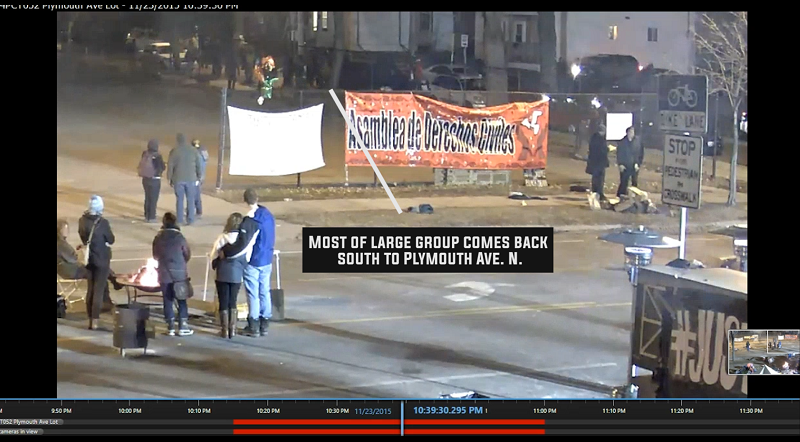
Freeman continued to roll the tape, which was shown on a large screen on the back wall of the courtroom between the witness stand and the jury box. At the 10:40 p.m. spot, the small amounts of the crowd that were on Morgan Avenue are seen frantically running south towards Plymouth and one minute later O’Rourke says the “crowd is running in all directions.”
At the 10:46 mark, police lights are seen in the video pulling up to the scene. This was approximately six to seven minutes after the eight bullets were shot from Allen Scarsella’s Remington 1911. Freeman is then done showing the court Exhibit 110.
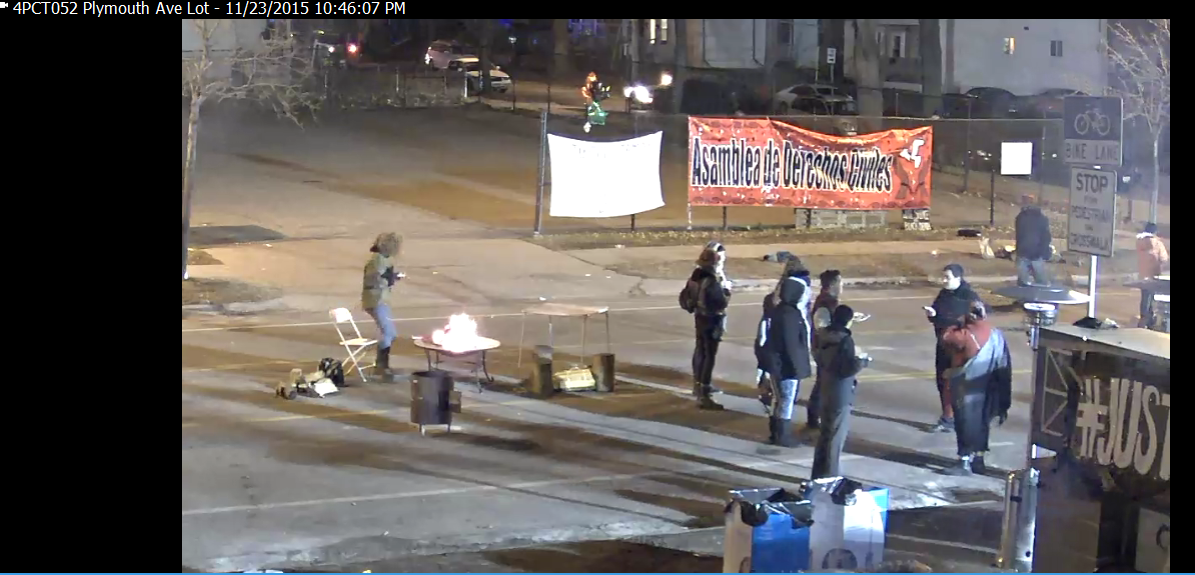
Exhibit 111, a video shot by an unknown “reporter” is then published and presented to the court. The video was taken from Morgan Avenue during the time that the group of protestors were following Scarsella’s group as they left.
Clearly visible at certain points in the video are Scarsella and Gustavsson, who had a orange boombox. Scarsella and his cohorts are trailed by people that seem to be no closer than ten to twenty feet. The camera person walks across Morgan and turns the video off as they stand near a light pole.
Exhibit 112 is then quickly shown to the court. This is another video shot by the same person as Exhibit 111, and it was recorded just mere seconds after the shooting.
This video shows a dozen or less people running south on Morgan Avenue. Commotion can be heard in the video and someone near the camera person is heard saying “that’s how you know, they was who we said they were” and then a frantic person can be heard screaming “MEDIC!”
In the ensuing moments after the gunshots, people were seen scrambling for safety while others were seen rushing to help the screaming victims, and some were simply standing there, seemingly shocked. The video cuts out as the dramatic scene continued to unfold. Freeman had no more questions for O’Rourke.
Defense attorney Heinrich focused hard on the video in cross-examination, speaking about how O’Rourke could be mistaken from the video because it was grainy and pixelated. She went as far as saying “you don’t have any special training on how to identify people on a video, correct?,” to which O’Rourke paused and answered “correct.”
Heinrich focused on how she saw that it wasn’t a majority of the group that came back down to Plymouth Ave. before the shots were fired. She questioned if O’Rourke counted all of the people that he saw in the large group to see if it was in fact a “a majority of the group” that came back down to the precinct. She made clear her perception that a sizable group continued to follow Scarsella’s group.
Heinrich questioned O’Rourke about the three videos that were just shown to the jury, challenging him on what she called his “guess” that they were taken at the same time. O’Rourke chided back, “no, it was my observation … I look at the following video and it’s the exact same people doing the exact same thing, it bares obvious that it’s two videos being taken at the same time from two different points of view. It’s not just an assumption.” The defense was done with cross-examination after less than ten minutes.
During re-direct, Assistant Hennepin County Attorney Freeman then spoke about the specialized knowledge of what the perpetrators looked like that was gathered from observing the videos and ended the questioning of O’Rourke, who was then let off the stand.
Katharine Engdahl, an employee with the State of Minnesota was the next witness called up by the State in the prosecution of Allen Scarsella. Katharine Engdahl said she “was present at the protest [4th Precinct] for the majority of the days.” She stated that she mostly came week nights and on the weekends.
She said that the protests became personal for her because she had a friend recently pass away who told her before he passed that “he hated being black.” Engdahl said of the protests at the 4th Precinct that,
“It was one of the few places I didn’t feel grief stricken, really nice community.” – Katharine Engdahl speaks of the welcoming community at the 4th Precinct protests
Hennepin County attorney Judith Hawley directed Engdahl to the night of November 19th. She asked if Engdahl had seen the video that Julio Suarez and Allen Scarsella made on their way to the 4th Precinct (Exhibit 44, seen below). Engdahl said she had seen it and that “it was scary” and the presence of the gun and the things that were said on the video made her and her friends fearful.
Hawley asked if there were leaders at the 4th Precinct protests, to which Engdahl replied that there were people in the “leadership capacity in the loosest sense“, she said that the ‘leaders’ were “people who would help situations, tell you if there was food available, or deescalate situations … make sure everybody was safe.”
Hawley asked if there was any notable changes after the first video and armed visit to the protest by Scarsella on the 19th. Engdahl said “people started to feel really tense because they were scared, after the video came out, they were worried about these men coming back causing real harm to those of us in attendance.”
Engdahl further stated that because of that fear and paranoia and because Scarsella and Suarez were masked up, ‘community leaders’ asked that “white people not wear face masks.” She stated that there had always been an unwritten ‘no-facemask’ rule, but the armed visit accentuated more attentiveness to the people who were walking into the area of the protest and that people approached newcomers to welcome them.
Engdahl stated that she was present on the night of the shooting, November 23rd, 2015. She said that people were so tense in the days before but “that night was sort of the first night that everybody started to relax again.” She said it “was a really nice night” with people dancing, eating, talking, and staying warm around the fire pits on Plymouth Avenue.
Engdahl said that she was standing in the middle of Plymouth Avenue around 10:30 p.m. with her back to the precinct, speaking with friends around the fire pits when she saw Scarsella and his three friends walk past Morgan Avenue and stand near a fence on the corner. She said that when people would arrive to the protest, they would normally walk in and participate, but these men walked in and stayed at the fence with face masks on and “seemed to be avoiding everybody.”
Hawley continued to question what she saw after Scarsella and his friends stood there, to which Engdahl responded that she saw someone approach them and then a couple more “people started walking up, and at one point I heard yelling coming from the four men, and I heard one of them shout the ‘n word’ at, um, a couple of the black guys” in the group.
She said that ‘community leaders’ then started escorting them off the premises and that she followed until they got about halfway down Morgan Avenue and then the group stopped and started walking back to the precinct. It was then that Allen Scarsella fired eight bullets from twenty or so feet north of 14th Avenue, one block north of Plymouth Avenue.
Engdahl, who was just south of the east-to-west alley running from Newton Avenue to Morgan Avenue, close to Plymouth Ave., when the shots were fired, said she didn’t know if they were “fireworks or gunshots” and shortly afterwards she heard someone scream that “someone’s been shot.”
Engdahl then called 911 immediately and told the address to the operator. Engdahl stated that she saw Teven King “lying on his back with hand on his stomach … there were three or four people putting pressure on his wound.”
Engdahl said that people were in fear after the shooting and commotion ensued, she said that “there was people crying, people sprung into action and started helping other people.” She said that she saw three victims that were shot, and after she called 911, she stayed in area. She said she witnessed “rising tensions” between protestors and police as they arrived at the scene, and a police officer released mace into the crowd.
Hawley asked “what happened next?,” to which Engdahl responded that she came into contact with Teven King’s partner and she drove her to the hospital and sat with her while she was there. She said that she spoke with police at the hospital and later at City Hall she was interviewed by Sgt. O’Rourke and provided a video that she had taken which showed the four men standing at the fence. Her video was just fifteen seconds long as her phone ran out of memory while she was recording it. At that point, the State had no more questions.
Defense attorney Laura Heinrich led the cross examination of Katharine Engdahl by asking what the police response was to the protests, to which Engdahl stated that the police would peer into the crowd from behind the precinct wall using a ‘cherry picker’.
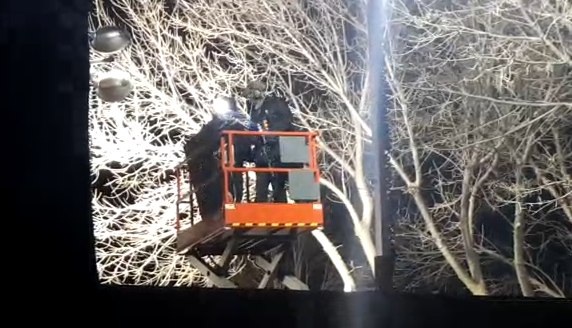
Heinrich then asked “were you there during any of the events when molotov cocktails were thrown?,” to which Engdahl said she didn’t believe so. Engdahl was then asked if she was there during the times when police shot “rubber bullets,” to which Engdahl said she had seen the police shoot “marking rounds” at protestors.
Heinrich spoke about the interview that Katharine Engdahl had done with Sgt. O’Rourke in which she described what she had seen that night. Engdahl stated to O’Rourke that she saw four people enter the protests and three had ski-masks on and one a bandana around their face. Heinrich continued reading off different quotes of Engdahl’s interview with O’Rourke and noted that Engdahl said some of the protestors “circled” the four men to get them to leave.
In Engdahl’s interview with O’Rourke at City Hall on the night of the shooting, she never stated that one of the men said the ‘n word’. Engdahl said that she was not aware that the statement was being recorded and that she “was in shock” when she met with O’Rourke and thought she was meeting with him to primarily give him the fifteen second video clip. The cross-examination was then complete.
Redirect from State asked about the interview with O’Rourke and how Engdahl was asked what happened, but mainly was asked what the shooters looked like because they were unknown to the police at that point. In attempts to prove that Engdahl’s interview was short, Hawley said that her transcript from the interview was just two and a half pages long.
We will pick up our Scarsella Trial report-back Part Four with further testimony from January 20 and beyond.
Read all ten comprehensive report backs by clicking the titles, Part One: Jury Selection, Unicorn Riot Subpoenaed, Opening Statements | Part Two: “In hindsight it was very stupid” | Part Three: Jury Sees Videos Around Mass Shooting | Part Four: Shooting Victims Testify | Part Five: Cell Phone Extraction Shows Scarsella’s Hardened Racism | Part Six: Defense Attempts to Discredit Protesters Using Police Videos, | Part Seven: Co-Defendant Waives his 5th, Testifies for White Supremacist, | Part Eight: Scarsella Takes Stand, Admits Shooting, Claims Self-Defense, | Part Nine: Defense Rests & Closing Statements, | Part Ten: Scarsella Guilty of 12 Felonies, Sentenced to 15 Years, or by clicking on the images below:
To see Unicorn Riot’s past coverage in relation to this shooting, see below:

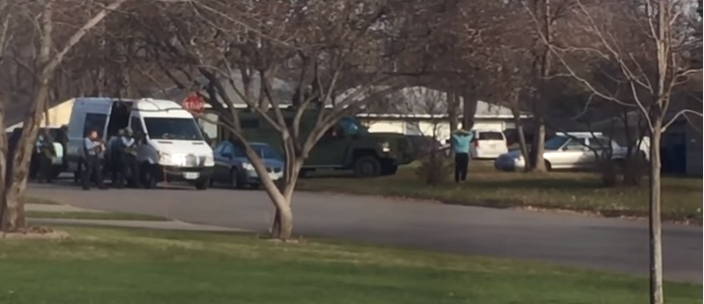
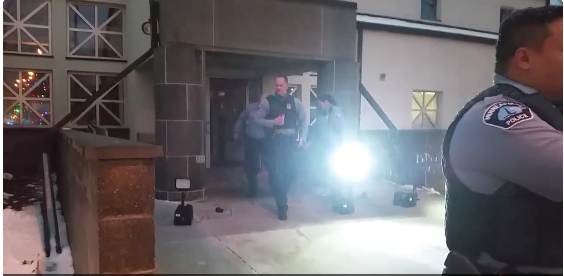
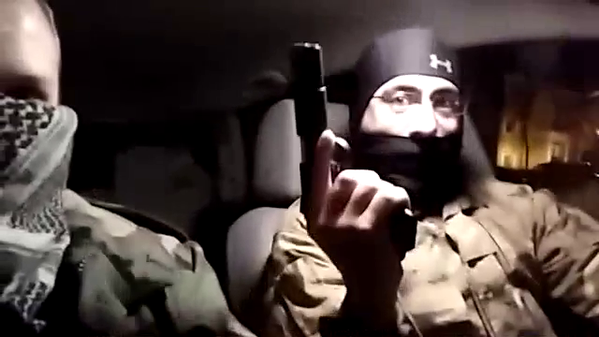
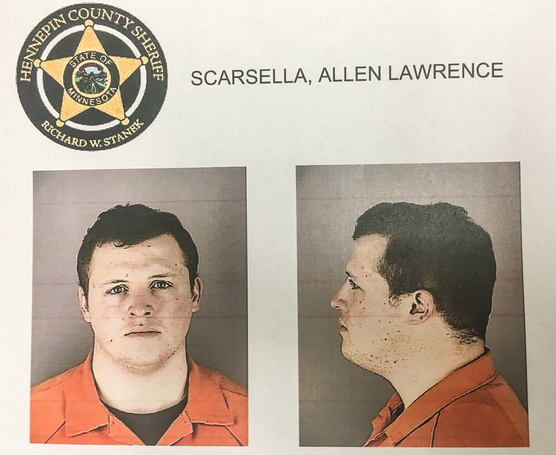
To help our volunteer-operated horizontally-organized non-profit media collective, please consider a tax-deductible donation:
Scarsella Trial Reportbacks & Coverage of Shooting at 4th Precinct:
- White Supremacists Shoot Five Protesters and MPD Attacks #Justice4Jamar Crowd - Nov 24, 2015
- “Play Stupid Games, Win Stupid Prizes”: White Supremacists Arrested for Shootings - Nov 26, 2015
- #Justice4Jamar Assailants Net Minor Charges; Camp Braces for Police Action - Nov 30, 2015
- Hiding Hate Crimes: Prosecutor Goes Easy on Attempted Murderers - Mar 15, 2016
- Bail Motion Denied for White Supremacist 4th Precinct Shooter - July 6, 2016
- Reportbacks From the Scarsella Trial (Ten Part Series) - May 1, 2017
- Scarsella Trial – Part One: Jury Selection, Unicorn Riot Subpoenaed, Opening Statements - Jan 27, 2017
- Scarsella Trial – Part Two: “In hindsight it was very stupid” - Feb 4, 2017
- Scarsella Trial – Part Three: Jury Sees Videos Around Mass Shooting - Mar 4, 2017
- Scarsella Trial – Part Four: Shooting Victims Testify - Mar 8, 2017
- Scarsella Trial – Part Five: Cell Phone Extraction Shows Scarsella’s Hardened Racism - Mar 13, 2017
- Scarsella Trial: Part Six – Defense Attempts to Discredit Protesters Using Police Videos - Apr 12, 2017
- Scarsella Trial – Part Seven: Co-Defendant Waives his 5th, Testifies for White Supremacist - Apr 25, 2017
- Scarsella Trial – Part Eight: Scarsella Takes Stand, Admits Shooting, Claims Self-Defense - Apr 26, 2017
- Scarsella Trial – Part Nine: Defense Rests & Closing Statements - Apr 26, 2017
- Scarsella Trial – Part Ten: Scarsella Guilty of 12 Felonies, Sentenced to 15 Years - Apr 27, 2017

